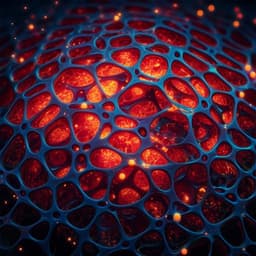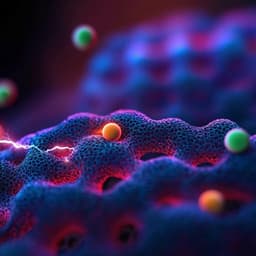
Chemistry
Systematic screening of gas diffusion layers for high performance CO₂ electrolysis
A. A. Samu, I. Szenti, et al.
This groundbreaking study by Angelika Anita Samu and colleagues systematically evaluates gas diffusion layers for CO₂ electrolysis to CO, enhancing energy efficiency and tackling performance decay. By analyzing various GDL characteristics, researchers unveil crucial factors influencing CO₂ reduction performance and selectivity.
~3 min • Beginner • English
Introduction
The study addresses the urgent need to reduce atmospheric CO₂ by evaluating electrochemical CO₂ reduction (CO₂RR) in gas-diffusion-electrode-based electrolyzers as a route to convert CO₂ into useful products using renewable energy. To meet industrial viability, CO₂ electrolyzers must operate at low cell voltage, high current density, high selectivity, and long-term durability. Traditional H-cells are mass-transport limited by CO₂ solubility; gas-fed zero-gap cells with gas diffusion electrodes (GDEs) overcome this by minimizing diffusion layer thickness and creating extensive triple-phase boundary. Within GDEs, gas diffusion layers (GDLs) are crucial for delivering CO₂ to catalysts, providing electrical contact, mechanical robustness, and water management. Carbon-based GDLs are favored for tunable porosity, conductivity, and cost, but most selections for CO₂RR have historically been borrowed from fuel cell applications where conditions differ. The paper aims to systematically determine which GDL parameters—microporous layer (MPL), PTFE content, thickness, and carbon fiber orientation—most strongly impact CO₂RR performance in a controlled zero-gap electrolyzer.
Literature Review
Prior work has explored carbon-based GDLs across technologies such as oxygen-depolarized cathodes and fuel cells, noting that key properties (gas permeation, resistance) depend on compression and setup. The MPL, typically made of carbon nanofibers or powders, improves homogeneity, roughness, and distribution of gas and current. Hydrophobizing agents like PTFE increase durability but present trade-offs: higher hydrophobicity can suppress HER and favor CO₂RR selectivity, yet can impede gas transport and electrical conductivity at high loadings. Studies have highlighted the roles of porosity, MPL presence, wetting properties, and crack formation in electrolyte and water management, impacting selectivity and flooding. GDL structure also influences salt precipitation at the cathode and stable operation. Despite these insights, comprehensive, controlled comparisons of commercially available GDLs in CO₂RR have been scarce, particularly isolating MPL presence, PTFE content, thickness, and fiber structure under standardized electrolyzer conditions.
Methodology
A zero-gap electrolyzer cell (active area 8 cm²) with both electrodes pressed directly against a Sustainion X37-50 Grade-1 anion exchange membrane was used. Cathode: Ag nanoparticle catalyst layer (spray-coated onto GDLs) forming ~25 μm thickness; loading 1.0 mg cm⁻². Anode: Ir-coated 1 mm porous Ti frit (1.0 mg cm⁻²). Cell temperature: 60 °C. Anolyte: recirculated CsOH (0.1 M for short-term, 0.05 M for 100 h long-term tests). Cathode feed: humidified CO₂ at 12.5 cm³ cm⁻² min⁻¹. Twenty commercially available carbon GDLs from six manufacturers were screened, differing in MPL presence, PTFE content, thickness (≈150–500 μm), and fiber structure (woven vs non-woven; straight vs spaghetti-like). GDE compression was controlled by PTFE gaskets; for each GDL, the cathode spacing (compression ratio) was optimized via stepwise reduction to ensure good contact without structural damage (optimized values reported in Table 1). Electrochemical testing employed consecutive 1-hour chronoamperometric steps at multiple cell voltages (including 2.6, 3.0, and 3.2 V) to quantify partial current densities for CO and H₂, with total Faradaic efficiency near 100% (CO and H₂ only detected). For deeper assessment, the six best-performing GDLs were re-tested at five cell voltages in replicate, and two were subjected to 100-hour continuous electrolysis at ΔU = 2.8 V. Physical characterization prior to electrolysis included contact angle measurements (0.1 M CsOH droplets) on MPL and CFL sides, SEM for surface morphology (especially MPL cracks), and X-ray micro-CT for internal structure and MPL thickness. Capillary breakthrough pressure data from literature were compared to electrochemical metrics.
Key Findings
- Presence of MPL is decisive: For GDL pairs sharing the same carbon fiber layer (CFL), MPL-free variants showed low CO₂RR selectivity and favored HER, whereas MPL-containing counterparts achieved CO with >90% Faradaic efficiency under the same conditions.
- High-rate CO formation at modest voltages: At 3.0 V, five GDLs (SGC 28BC, SGC 39BB, FRG H23C6, TH60 MPL, LT 1400W) exceeded 500 mA cm⁻² partial CO current density; the maximum was ~600 mA cm⁻² with SGC 39BB. Across GDLs, raising cell voltage increased total current but also HER, lowering CO selectivity.
- At 2.6 V, all six best-performing GDLs delivered >200 mA cm⁻² CO partial current density. At 3.2 V, four GDLs (SGC 39BB, SGC 28BC, TH60 MPL, LT 1400W) achieved >530 mA cm⁻² CO partial current; CO/H₂ ratio remained >10 for SGC 39BB, TH60 MPL, and LT 1400W.
- Structural effects: Woven vs non-woven CFLs showed minimal impact on rate; spaghetti-like fibers exhibited slightly lower selectivity and appeared more prone to wetting than straight fibers.
- Hydrophobicity (contact angle) alone does not predict performance: Most MPL surfaces showed 140–150° contact angles; only FRG H23C2 (no PTFE) was lower (131°). GDLs with the highest contact angles were not the best performers, likely due to pore blockage at high PTFE loadings.
- MPL cracking correlates with improved performance under these zero-gap conditions: GDLs with more/larger MPL cracks (e.g., TH60 MPL ~12% cracked area, ~40 μm average crack width; SGC 28BC ~2% cracked area, ~10 μm width) tended to perform better, potentially aiding water management. However, cracked vs crack-free GDLs both appeared among top performers, indicating non-universality.
- Thickness: Little effect on short-term rates, with a slight increase in CO selectivity at higher thickness; thicker GDLs required higher compression but showed better long-term stability.
- Long-term stability (100 h at ΔU = 2.8 V): SGC 39BB and TH60 MPL maintained stable total current and CO selectivity with a degradation rate of ~140 μA cm⁻² h⁻¹ over the last 72 h. A thinner SGC paper exhibited faster decay (~340 μA cm⁻² h⁻¹).
- Total FE remained near 100%, with only CO and H₂ detected.
Discussion
The systematic screening isolates the GDL parameters most influential to CO₂RR in a zero-gap electrolyzer. MPL presence emerged as the dominant factor in suppressing HER and enabling high CO selectivity, likely by increasing hydrophobicity and providing a more homogeneous, higher-area interface for catalyst–gas–electrolyte interaction. While hydrophobicity is necessary to mitigate flooding, contact angle alone is not a reliable predictor of performance, as excessive PTFE can occlude pores and hinder gas transport. The microstructural feature of MPL cracks appears beneficial for water management in this configuration, facilitating removal of excess water arriving from membrane diffusion and humidified gas, thereby maintaining access of CO₂ to the catalyst. However, since both cracked and crack-free MPLs can perform well, the benefit is context-dependent. Fiber orientation and weave (woven vs non-woven; straight vs spaghetti) showed minimal influence on rate, though spaghetti fibers correlated with slightly lower selectivity due to increased wetting. Thickness modestly improved selectivity and substantially enhanced durability in long-term operation, possibly through mechanical robustness and optimized compression that improves catalyst–membrane contact. Overall, these findings refine GDL selection criteria for CO₂ electrolyzers: prioritize MPL-containing substrates with appropriate, not excessive hydrophobicity and consider MPL crack morphology and GDL thickness for stability, while fiber weave/type is a secondary factor.
Conclusion
Twenty commercially available GDLs were benchmarked for CO₂-to-CO electrolysis in a controlled zero-gap cell. The presence of an MPL is essential to favor CO₂RR over HER, largely independent of CFL PTFE content. Short-term performance is relatively insensitive to GDL thickness, though thicker substrates yield slightly higher CO selectivity; in long-term tests, thicker GDLs afforded more stable operation. MPL crack density and morphology, under the applied conditions, correlated with improved performance, likely via enhanced water management. The best GDLs routinely delivered >200 mA cm⁻² CO partial current at 2.6 V and up to ~600 mA cm⁻² at 3.0 V with high selectivity. Future work should optimize GDL properties (MPL formulation, controlled crack engineering, PTFE distribution) and operating parameters (compression, humidity, temperature, electrolyte) for each GDL to maximize durability and efficiency under industrially relevant conditions.
Limitations
Findings are specific to the zero-gap cell design, operating conditions (60 °C, CsOH anolyte, humidified CO₂ at 12.5 cm³ cm⁻² min⁻¹), and the optimized compression ratios used. Contact angles were measured on unused GDLs; operational wetting may differ. ECSA determination was not feasible due to MPL hydrophobicity. Long-term durability was demonstrated for two GDLs (100 h) and a single operating point; broader condition mapping and GDL-specific optimization are needed. Correlations with capillary breakthrough pressures were inconclusive, and the beneficial role of MPL cracks may not generalize to other cell architectures or conditions.
Related Publications
Explore these studies to deepen your understanding of the subject.







